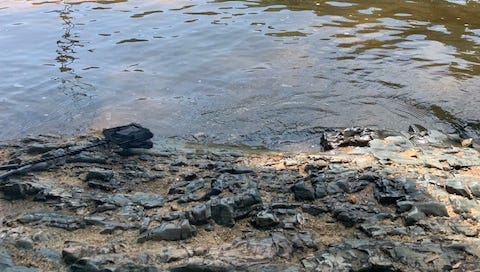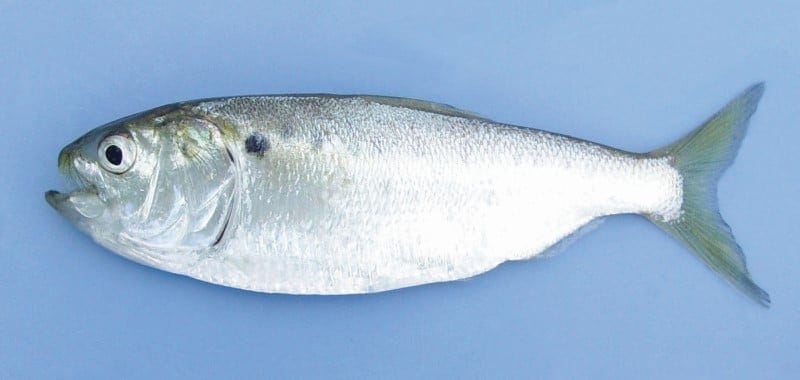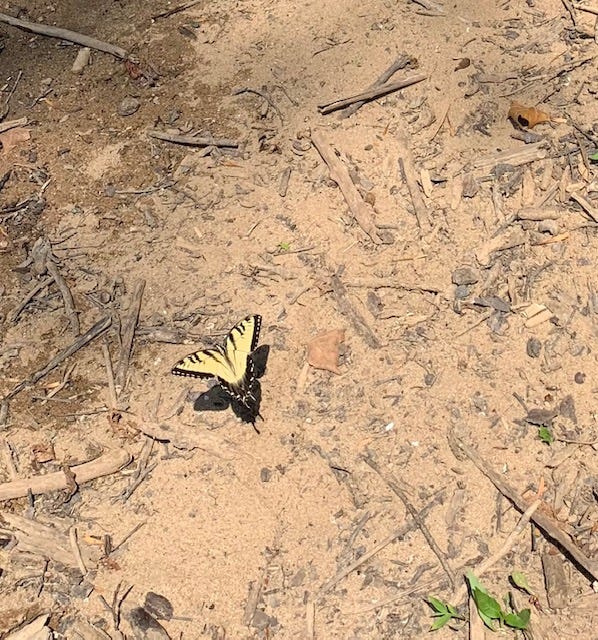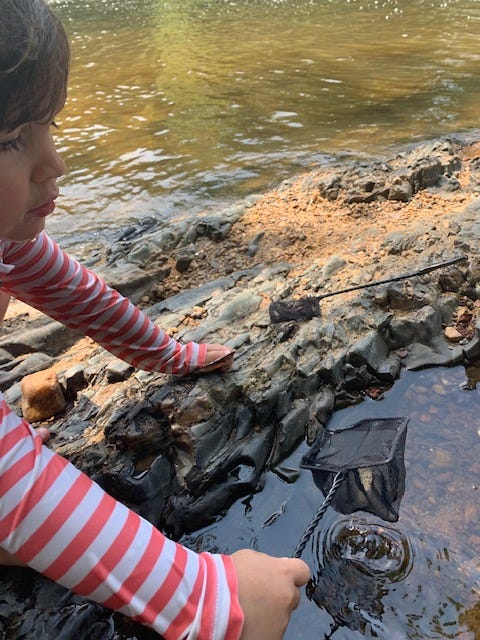The other day, driving to Bea’s summer camp, we heard an NPR story about a shark comeback off the coast of Long Island. After years of decline, sharks are finally being spotted again. Instead of being scary (shark attacks are rare! only 73 a year in the whole world!), this was good news to ocean researchers, because the presence of top-line predators is a sign of a healthy ecosystem.
It turns out that the reason for the sharks’ return is connected to this fish, known as bunker or baitfish:
For years bunker were overfished by commercial fisherman, mostly for use in pet food and fish oil supplements. Sharks love to eat bunker, and by protecting or regulating bunker fishing (ending a commercial fishing “free-for-all,” as scientist Chris Paparo told Morning Edition), the government was able to help sharks. And the return of sharks means a return of balance to the ecosystem.
So what does this have to do with rivers? Well, it reminded us that the presence of larger predators is a sign of healthy water, and also that regulation, or making rules about what humans can and can’t do, is the key to keeping our waters healthy for all—humans, animals, and plant life.
We took a recent trip to the Haw River with our friend Miles and marked all of the animals, and signs of animals, that we saw in and out of the water. We saw:
Lots of small fish (including some toe-nibblers)
Turtles sliding off logs
Beaver activity
Eastern tiger swallowtail butterflies
Damselflies and dragonflies and cicadas
Swallows nesting under the Chicken Bridge
Clams and mussels (including piles we think were made by river otters)
Water striders, damselfly larvae, and mosquito larvae
We were hoping to see our favorite apex predator, the bald eagle, but no luck—still, we know they’re around because they nest all up and down the Haw, including just across the river from one of our favorite spots. We often see or hear them, and Harriet’s favorite game, for a while, was “speaking” back to them (a bald eagle call sounds like this). Their return to the American landscape is one of the big comeback stories that also came from protective rules, against hunting and pesticides, made by the federal government.
I’ve lived near the Haw, off and on, for sixteen years now, and I’ve definitely seen more fish and a greater diversity of animals as the years have passed. The presence of these animals, especially the bigger fish and raptors, is a good sign that the river is getting healthier, because the presence of these predators show that they have enough food to eat.
Back in the day, long before Richard and I moved here, the Haw wasn’t a place to swim or watch animals—textile mills and factories dumped so much waste into the water that a neighbor who worked in the mills remembers when the river used to run different colors, depending on the dye released that day. The Clean Water Act of 1972 and the North Carolina water regulations that came after helped the river get healthier by stopping factories and mills from dumping waste and poisons into the water.
Today, the biggest problem for the Haw River isn’t the textile industry, but other kinds of commercial activity—mostly farming, factories, and wastewater from towns and cities. We need farms, places to live, and factories to make things. But when people can farm without worrying where pesticides and waste wind up; build houses without worrying about erosion, runoff, and where the wastewater ends up; and run factories that produce dangerous chemicals that get dumped into our water, the river suffers. And when the river suffers, we do too—not only because we love to swim, splash, and enjoy its beauty, but because the Haw River watershed provides drinking water to many people, including our neighbors in Pittsboro.
We’re going to talk more next week about how the town of Pittsboro, the state of North Carolina, and the Environmental Protection Agency are all doing to protect our watershed and yours—and what we can all do to help.
We’re curious, have you seen the watershed where you live get healthier or less healthy since you’ve lived there? How can you tell?
I’ll be back Sunday with thoughts on The Ministry for the Future, which I finally finished. And some bonus book recommendations from Harriet.
See you then, Frog Troublers!
In the meantime, enjoy this video of sharks dividing and conquering this giant school of bunker:








I did some work on behalf of the Ogeechee River in Southeast Georgia, which is also a black bottom river and unimpounded. Back in ~2012 there was a fishkill in the lower river (i.e. most of it) due to a textile finishing plant that waterproofed garments and then dumped whatever sludge right into the river (by permit!) ... anyway, that plant changed hands after a settlement and just yesterday the buyer announced that it would be CLOSED! Hallelujah! And even a couple years ago (2017?) an old shad and sturgeon fisherman named Fulton Love was making nets again... so he must be very happy today.